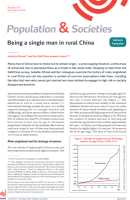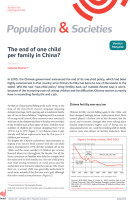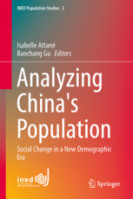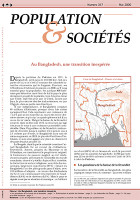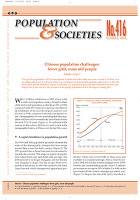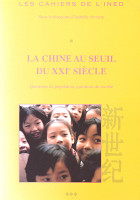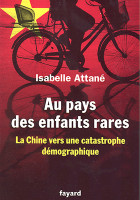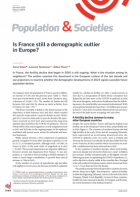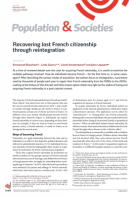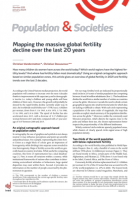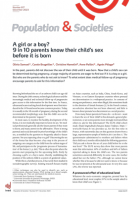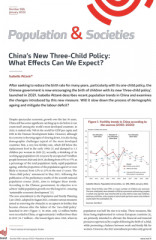
China’s New Three-Child Policy: What Effects Can We Expect?
Population and Societies
n° 596, January 2022, 4 pages
DOI:10.3917/popsoc.596.0001
French Institute for Demographic Studies
In 2021, China amended its Population and Family Planning Law for the second time
in an attempt to increase the birth rate by permitting couples to have three children.
This recent amendment ends nearly 50 years of strict coantrol over births.
However, these new family planning measures may fail to boost fertility in the short
term. Allowing a third child may have little effect in the short term given that having
a third child involves already having had a first one, then a second.
The new policy will not change the individual aspirations of young adults. Spending
longer in education (especially for women), seeking personal development (which now
takes precedence over the desire to start a family), and gender inequality are all
factors that may explain why young people are getting married later and later and
having fewer and fewer children.
fertility, birth rate, family planning, one-child policy, three-child policy, gender selection, population ageing, China
Table of contents
- Appendix A References
1.
After seeking to reduce the birth rate for many years, particularly with its one-child policy, the Chinese government is now encouraging the birth of children with its new ‘three-child policy’, launched in 2021. Isabelle Attané describes recent population trends in China and examines the changes introduced by this new measure. Will it slow down the process of demographic ageing and mitigate the labour deficit?
Despite spectacular economic growth over the last 30 years, China still has some significant catching up to do before it can count itself among the world’s most developed countries: in 2020, it ranked only 79th in the world for GDP per capita and 85th in the Human Development Index. However, although its economy is showing signs of slowing down, it is also facing demographic challenges typical of the most developed countries: first, a very low fertility rate, which fell below the replacement level in the early 1990s [1] and slumped to 1.3 children per woman in 2020 [2]; secondly, a shrinking of its working age population (20–64 years) by an expected 70 million people between 2020 and 2035, declining from 65% to 57% as a percentage of the total population; lastly, rapid population ageing, with the proportion of the population aged 65 or over likely to increase from 12% to 21% in the next 15 years. The ‘three-child policy’ announced in May 2021, following the publication of the preliminary results of the seventh national population census (2020), aims to mitigate these trends. According to the Chinese government, its objective is to achieve ‘stable population growth over the long term’, ensuring ‘sustainable economic development’ [3].
The new amendment to the Population and Family Planning Law (2002), adopted in August 2021, contains various measures aimed at removing the obstacles to an upturn in fertility that became obvious after the failure of the ‘two-child policy’ launched in 2015 (Figure 1). In 2020, only 12 million births were recorded in China, or approximately 3 million fewer than in 2019 (14.7 million)—the lowest figure since 1960, when its population was half the size it is today. These measures, like those being implemented in various European countries [4], are primarily intended to alleviate the financial and material pressures experienced by couples following the birth of a child, while promoting a balance between work and family life for women. However, the 2021 amendment provides only general principles; the details of how these new family planning measures are to be implemented are left, as with previous ones [5], to the discretion of provincial governments.

1.1. Encouraging births
The first amendment of the law, applied in 2015, removed three major barriers to an increase in fertility: the one-child limit (or two or three in certain cases), the encouragement to delay marriage and procreation (Art. 18), and the obligation for couples of childbearing age to use contraception (Art. 20) [1]. The 2021 amendment marks a radical change of approach by laying the foundations for a pronatalist policy. It encompasses two major changes: first, the option for all couples to have a third child, regardless of where they live (in an urban or rural area) or their ethnic background; secondly, a shift in the language used about age at marriage or childbirth, which should now be ‘appropriate’. Although no age limit is recommended at this stage, the amendment intends to counter the rapid rise in the average age of women at first marriage and, therefore, at the birth of their first child (Table 1) in order, it appears, to maximize the number of women in a partnership at the most fertile ages. The non-mandatory nature of birth control and the freedom to choose contraceptive methods used, both introduced in the 2015 amendment, are also reiterated in the 2021 version of the law. However, family planning ‘in accordance with the law’ remains a legal obligation (Art. 17), and rewards—the nature of which is not specified—are promised to couples who comply with the new provisions (Art. 23). Lastly, the ban on ultrasounds and abortions aimed at selecting the sex of the unborn child remains in place (Art. 39). According to the Decision of the Central Committee of the Chinese Communist Party and of the State Council by which the three-child policy was approved (dated 26 June 2021), the intention is to bring the sex ratio at birth back to a normal level by preventing the elimination of female foetuses. This ratio, despite falling since the late 2000s [1], remains highly imbalanced: 111.3 boys per 100 girls at birth in 2020 (Table 1), as opposed to the expected figure of around 105 in normal circumstances.

Another new measure introduced by the 2021 amendment aims to improve management of infertility (Art. 37). The acceleration of this phenomenon, which would now affect around 15% to 20% of women and 10% to 12% of men of fertile age (totalling nearly 100 million people) [7] and which is regularly cited as a cause of the low fertility rate, has become a major concern for the Chinese government. The Decision of 26 June 2021 provides a framework for the development of fertility treatment and medically assisted reproduction services.
1.2. Facilitating work–life balance
The unequal distribution of tasks between men and women within the family and the discrimination faced by women in the workplace are some of the causes of low fertility in China [1]. As such, the issues of gender equality, work–life balance, and better protection of women in the labour market have been placed at the heart of the 2021 amendment. Article 25, which in 2002 stated that ‘citizens delaying marriage and the birth of children could benefit from extended marriage and maternity leave entitlements’, was amended in 2015 to state that all women complying with the new provisions were entitled to this extension. The 2021 amendment reiterates the option of extending maternity leave—although it does not actually recommend any specific duration over the 128 statutory days—and goes further by implementing new parental leave, intended to encourage fathers’ involvement in childcare from a young age [6].
Another concern of the Chinese government is to limit the impact of childbirth on women’s employment opportunities, salary, and career. The focus is on combating discrimination against women at the point of recruitment, ensuring equal pay for equal work, and preventing unfair dismissal following maternity leave to avoid prejudice against women who become mothers. Two aspects of the law have been bolstered to support this: first, the protection of pregnant women and mothers in the labour market (Art. 26, revised in 2015 and 2021, stipulates that ‘the State guarantees the rights and interests of women with respect to employment and supports those whose career is affected by the birth of a child’) and, secondly, the development of infant childcare services both within local communities and companies (Art. 28, revised in 2021). The Decision of 26 June stipulates that companies should also adapt the working conditions of their employees (flexible working hours, working time, leave, etc.) to enable them to maintain a balance between family life and work life [3].
1.3. Reducing the financial burden on families
Another major change introduced by the 2021 amendment aims to alleviate the often prohibitive financial burden now associated with the arrival of a child for Chinese families [1]. This will be achieved, firstly, by increasing their income, through the payment of welfare benefits to those who have children ‘in accordance with the law’ (Art. 25) and the implementation of tax benefits (Art. 27). Secondly, expenses associated with the care of dependents (children and elderly relatives) will be reduced. Lastly, preferential measures are provided for concerning housing allocation, access to employment for parents, and access to education for children. These general principles will, however, be supported by a reformulation of welfare and tax policies designed to favour families with minor children (particularly those under 3 years of age).
One goal is to reduce the costs incumbent upon parents for their children’s schooling (Art. 27). As stipulated by the Decision of 26 June, there is a need to standardize access to educational resources by making it less dependent on families’ financial capabilities, particularly by regulating out-of-school tutoring—a source of significant expense for parents trying to improve their children’s competencies in the context of an education system that has become highly elitist [1]. The Decision of 26 June 2021 also specifies that, to alleviate the financial burden faced by families and enable them to concentrate their resources on their children, their financial and material involvement in the care of their elderly relatives should be reduced. These measures should include preferential access to retirement homes for the parents of couples adhering to the new legal provisions, as well as a reduction in medical costs and support services [3].
1.4. What effects can we expect?
This new policy, the local implementation of which is yet to be defined, will not necessarily be able to eliminate all the obstacles to an upturn in fertility, revealing the limits of the Chinese government’s interventionist policies when it comes to population. If the measures adopted at the local level prove enough of an incentive, they could certainly demonstrate efficacy regarding the work–family trade-offs that, since the 1990s and to an even greater extent than the birth-control policy itself, have dragged Chinese fertility downwards (high cost of schooling, poor protection of women in the labour market, underdeveloped infant childcare infrastructure, prospect of having to look after elderly relatives, etc.). On the other hand, the new policy will not have much grip on the individual aspirations of young adults, which will strongly determine their reproductive behaviour. Spending longer in education (especially for women), seeking personal development (which now takes precedence over the desire to start a family), and achieving increasing independence from parents in making decisions on marriage and family are all factors that may explain why young people are getting married and having children later and later. In fact, while the rate is still low compared with other countries in the region, the proportion of women who are single at age 30 has more than quintupled between 2000 and 2015 (from 2% to 10%), and the proportion of men has doubled (from 10% to 20%).
Allowing a third child will not significantly boost fertility in the short term, particularly since having a third child involves already having had a first child, then a second. As of 2015, only 1 in 4 women of fertile age had two children (Figures 2 and 3). If we apply this percentage to the population numbers identified in the 2020 census, it means that fewer than 85 million women will be affected by this new option. While the 2021 amendment does not provide any clarification on this point, it is likely that the incentive measures will have to benefit all births, irrespective of birth order, and target parents of only children and couples without children in particular. In addition, there is a concern that the Chinese government will continue, as it has done since the 1970s [5], to use coercion to achieve its demographic objectives. There is no sign in this amendment of any relaxation of the control that can be exerted over couples. Furthermore, the advantages offered to those who comply with the new provisions suggest that the social stigmatization of those who do not comply, as well as the penalties they may suffer, like those applied as part of the one-child policy (fines, professional or administrative sanctions, etc.) [5], may persist.


1.4.1. Box 1. Data sources
Uncertainties over the actual fertility rate in China have persisted since the 1990s. These uncertainties are fuelled by the inconsistencies observed between the various sources (censuses, annual birth statistics, intercensal surveys, fertility surveys, etc.) and reinforced by the opacity of the methods used by the statistics office to adjust the total fertility rate [8]. In particular, significant discrepancies (around 0.5 children on average between 2010 and 2015) can be observed between the values of the total fertility rate presented as the official one and the indicator extracted from the 2017 fertility survey [9] (Figure 1). Available data on birth and fertility rates also remain incomplete: the Chinese Statistics Office only publishes annual birth rates, which means that annual series (births, total fertility rate, and sex ratio at birth) for the intercensal period 2010–2020 have to be reconstituted based on information it randomly communicates to the public via the national press agency (Xinhua News Agency).
Appendix A References
-
[1] Attané I., 2016, The end of one child per family in China? Population & Societies, 535, July. doi:10.3917/popsoc.535.0001
-
[2] Press release, Xinhua News Agency, Xinhua wang, 17 May 2021 [in Chinese].
-
[3]
-
Decision of the Central Committee of the Chinese Communist Party and of the State Council, Xinhua News Agency, 20 July 2021 [in Chinese].
-
[4] Neyer G., 2006,
-
Family policies and fertility in Europe: Fertility policies at the intersection of gender politics, employment policies and care policies (MPIDR WP 2006-010), Rostock, Max Planck Institute for Demographic Research.
-
[5] Blayo Y., 1997, Des politiques démographiques en Chine, Paris, INED–PUF.
-
[6] Population and Family Planning Law (amendment of 20 August 2021), 3 September 2021 [in Chinese].
-
[7] Qiao J., Feng H., 2014, Assisted reproductive technology in China: Compliance and non-compliance, Translational Pediatrics, 3(2), 91–97. doi:10.3978/j.issn.2224-4336.2014.01.06
-
[8] Zhao Z., Zhang X., 2010, China’s recent fertility decline: Evidence from reconstructed fertility statistics, Population, 65(3), 451–478. doi:10.3917/popu.1003.0513
-
[9] He D., Zhang X., Zhuang Y., Wang Z., Jiang Y., 2019, China fertility report, 2006–2016, China Population and Development Studies, 2, 430–439. doi:10.1007/s42379-019-00022-9
In 2021, China amended its Population and Family Planning Law for the second time in an attempt to increase the birth rate by permitting couples to have three children. This recent amendment ends nearly 50 years of strict control over births.
However, these new family planning measures may fail to boost fertility in the short term. Allowing a third child may have little effect in the short term given that having a third child involves already having had a first one, then a second.
The new policy will not change the individual aspirations of young adults. Spending longer in education (especially for women), seeking personal development (which now takes precedence over the desire to start a family), and gender inequality are all factors that may explain why young people are getting married later and later and having fewer and fewer children.
Isabelle Attané
Cite the article
Isabelle Attané, China’s New Three-Child Policy: What Effects Can We Expect?, 2022, Population and Societies, no.596
 This document may be reproduced free of charge on paper or online using our Creative Commons licence.
This document may be reproduced free of charge on paper or online using our Creative Commons licence.

